How is Hardwood Flooring Made?
Not all hardwood flooring is created equal. Learn the differences between how enginerred hardwood and hardwood flooring is made. This will help you make an informed decision about what flooring will best fit your lifestyle.
There are three basic types of hardwood flooring:
- Solid
- Engineered
- Acrylic impregnated
Each type has advantages and disadvantages that should be considered for installation, wear and aesthetics.
Solid Wood Flooring
Solid wood floors are constructed of planks made from a single piece of wood with tongue and groove edges. Planks are delivered to factories pre-finished or unfinished. Manufacture of the flooring starts with the tree itself. After trees are cut into logs, what they will be used for is determined by the quality of the tree. Trees marked for flooring are chosen for natural beauty with tight grain and few knots. The chosen logs are cut into rough planks. There are a variety of cutting methods used which affect the stability and price of the board. Below are three of the most popular:
- Flat or plain sawn: by far the most commonly used cut. It contains more variations than the others.
- Quarter sawn: cuts a log into quarters before it cuts the strips of wood to make hardwood flooring boards.
- Rift sawn: cuts a log at a different angle than quarter sawn before it cuts the wood into hardwood flooring boards. Though it is more expensive than the other methods, it is also more stable, providing higher quality flooring.
Cut planks are then graded for look. The next step is to plane the boards on all four sides to smooth saw marks and level the plank.
After planing, a machine cuts the tongue and groove edges in planks that make the boards fit together tightly. Tongue and groove construction allows the boards to expand and contract, without creating gaps between planks in the installed floor. Smaller shops without a tongue and groove machine use a mounted router to mill the edges.
At this stage, the planks may go through a distressing process to give them an older, antique look. This is done by hand (e.g. hand scraping or hand sculpting) or machine (e.g. wire brushing).
The final product is either sealed/stained with several coats of protective finish or shipped unfinished to the marketplace. Pre-finished floors offer easier installation, especially for the do-it-yourselfer, but floors finished after installation offer a more impenetrable seal to moisture from above and a more uniform look.
Some solid hardwood flooring is recycled from wood recovered and refinished from old wood, including sources like siding and floors once used in old factories, houses and barns and even from sunken boats or logs recovered from lakes and rivers. Reclaimed wood is sawn into the familiar proportions of flooring, re-planed, and finished. Hand scraping to produce an authentic antique look is a popular method of finish for this highly prized flooring.
The chief advantage to solid wood flooring is longevity. Because solid wood floors can be restored to their original beauty many times by sanding and refinishing, they can retain their beauty and structural integrity potentially for centuries.
Engineered Wood Flooring
Engineered wood flooring is constructed by gluing together a number of wood plies, with a veneer of real hardwood veneer glued on top. The plywood underneath the real hardwood veneer is referred to as the core board.
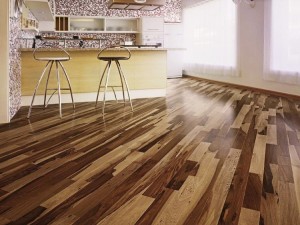
The plywood core board is made by stacking the plies one on top of another in opposite directions, then glued together. By crossing the plies the finished planks are much more dimensionally stable than solid wood planks, meaning they are much less likely to expand and contract in response to changes in temperature and humidity. This added dimensional stability means that engineered wood floors can be installed over concrete subfloors, over an in-floor radiant heating system and below grade. The more plies in the plywood, the more dimensionally stable the floor will be. The more plies, the greater the cost.
Engineered wood floors are also made with core boards made from high density fiberboard, or HDF. HDF is even more dimensionally stable than a plywood core board.
There are three different ways of cutting the real hardwood veneer that is glued on top of the core board. The cutting method, along with thickness, has an impact on price.
- Dry solid-sawn: involves letting the wood dry out slowly with a low humidity level to keep moisture from inside the wood cells intact, reducing the risk of cupping. It is the most expensive type of engineered flooring, but looks and acts more like a solid.
- Rotary-peel: involves boiling the log for a certain amount of time at a certain temperature to prepare the wood. After the wood has been prepared, it is scraped from the log with a blade working from the outside in and then pressed flat. It typically has a plywood-like grain and can have issues with cupping and warping to try to revert to its original shape.
- Sliced-peel: involves boiling the log for a certain amount of time at a certain temperature to prepare the wood. After the wood has been prepared, it is sliced from the end and then pressed to create a veneer.
All three cutting methods have their pros and cons. Dry solid-sawn is the lowest yield for the highest cost, but has the best visual appeal, and strongest grain structure due to the sawing process. The grain pattern looks just solid hardwood.
Rotary Peeled provides the highest use of raw materials for the lowest cost, but has the lowest visual appeal and weakest grain structure. The grain pattern resembles plywood.
Compared to rotary-peel, sliced-peel provides better yield with medium cost, better visual appeal, and better structural integrity.
The higher the quality of the engineered flooring, the thicker the top veneer usually is. Veneer thicknesses range from 0.6mm to 6mm and can be made from any species of wood. The thicker the veneer the higher the price. If the veneer is less than 2mm thick, the floor cannot be sanded and refinished.
Once the layers are glued together, the edges are milled for tongue and groove construction or for a glueless click-lock system.
It is important to understand the nature of the adhesive used to glue the layers together. Cheaper adhesives may emit unacceptable levels of formaldehyde. Engineered floors that are either E1 or E0 class or CARB-compliant are formaldehyde safe.
As with solid hardwood, some engineered planks will go through a distressing process such as hand scraping or wire brushing to give the floor an old, antique look.
At this stage, the product is sealed/stained with several coats of protective finish. Unfinished engineered wood flooring is also available, but not nearly as common as unfinished solid hardwood.
Acrylic Impregnated Wood Flooring
Engineered hardwood flooring can be strengthened for maximum wear by forcing, or impregnating, the wood with stain and a liquid acrylic that fills the cells and supports the wood structure. This type of flooring is extremely durable, resistant to impact damage, denting and heavy-traffic wear. Because the stain is forced into the wood, the color goes all the way through the top layer, so worn spots will not appear different color, and areas exposed to the sun will not fade.
To process the acrylic impregnated veneer wood, the wood is first placed in a vacuum to remove all the sugars and sap, leaving the cells dry and empty, resembling the cellular structure of cork. A liquid acrylic called methylmethacrylate (MMA) is forced into the empty cells to replace the original sap. If the wood is to be stained, it is mixed with the acrylic before the impregnation. After it dries, the veneer is sanded and glued to the core material. The final product is sanded again and finished. This produces a surface up to 300% harder and more durable than natural wood, a great choice for commercial building applications.

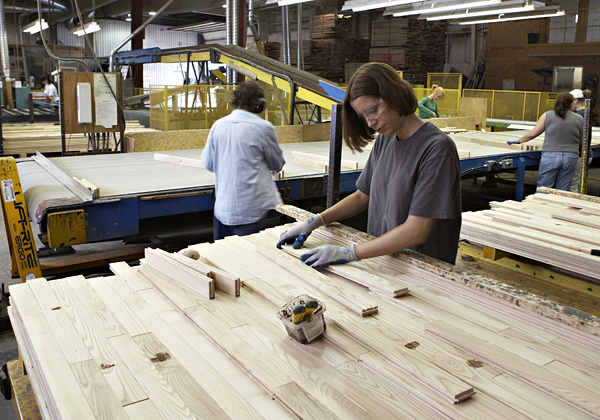
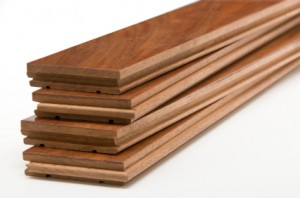
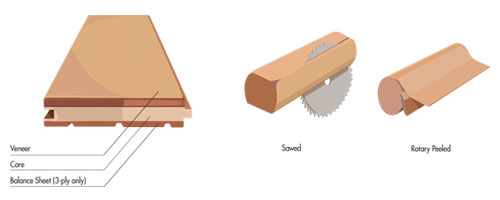
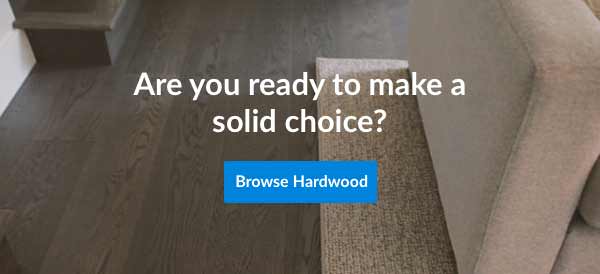

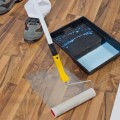


Pingback: Hardwood VS Laminate Wood Flooring: Which Is Better? Laminate Hardwood Flooring Has Pros & Cons - Real Wood Differs From Wood Laminate Flooring | The Homebuilding/Remodel Guide
lameck
I need to know more about the laying techniques for wooden floors as well as how wood is fixed to prevent movement and creeking.
BuildDirect Product Expert Team
Hi Lameck,
Wood floors can be nailed, stapled, glued or floated. These installation methods will vary depending on which product you choose. For example, this hardwood is nailed down while this one is glued down.
There are different laying patterns suited for individual preferences – straight, random, diagonal, parquet and herringbone.
Movement and creaking is prevented by proper installation with the right underlay and consistent climate control. Check out our sound dampening underlays!
As always, installation instructions are available on each product’s page on our website and can be emailed to you upon request.
Thanks for your question!
Lucy
I wish you explain how to transform the cut tree into wood for water proof and regular. I have several pine and oak trees and would like to use some for artistic work some to be water proof and some not.
What is the process to dry the wood cut from the tree?
Anticipated Thanks.
Linda Stewart
Where can I find in what country the engineered wood flooring is made?
Rob Jones
Hi Linda,
This kind of information is usually included in product specs. Sometimes, wood is sourced from one region, and cut in another. So, sometimes there are multiple answers to this question of origin. Depending on how you’re getting it from, this will be published on web pages, included in packaging, or both. When in doubt, always ask your vendor directly.
Hope this helps!
Johnny
I noticed some of the solid hardwood planks in the box has a mark of bonding like two planks bonded together to increase the length. Is this normal from the hardwood maker? I bought a solid canadian maple hardwoord pre-finished and i see these out from the box.
Pingback: How Hardwood Flooring is Made, Part 2: Engineered Wood Floors
Pingback: How Hardwood Flooring is Made, Part 1: Solid Wood Floors
Troy O.
Flooring designers can also work on all of your rooms or just one, depending on your preferences and how many rooms you want to remodel in your home. You can select between a number of different finishes to create the hardwood design that flows best with your existing décor, and if you are unsure of the color that would look best in your home, a designer will give you insight and use their unique vision to determine what type of wood will work best in your space.
Hardwood oak flooring
If you are considering an engineered wood floor select a material with the bottom made up from a multi laminate plywood with ten laminates. This gives great stability and strength to your engineered wood floor. Buy a material with a 6 mm ware layer. This gives you an wood floor that will be as durable as a solid wood floor.
Pingback: Plywood vs. HDF core for dimensional stability? - DoItYourself.com Community Forums
Ann Luebke
It would be really helpful to know more about the finishing process. Are all four surfaces of each plank finished or just the top?